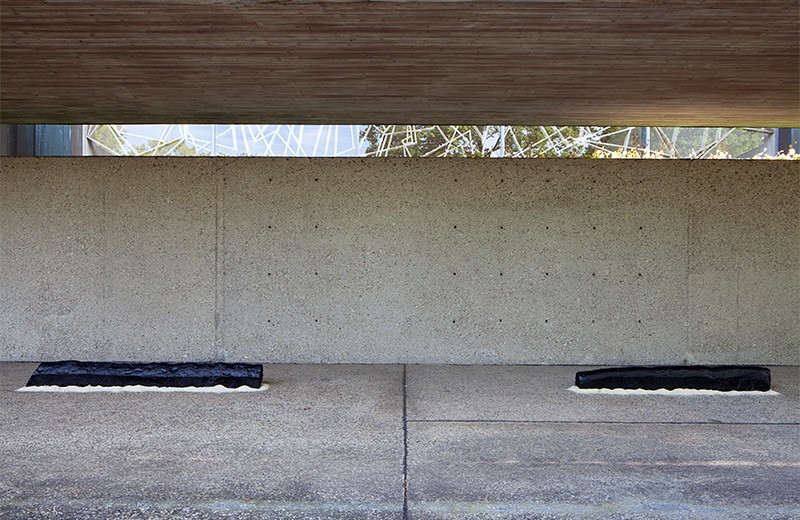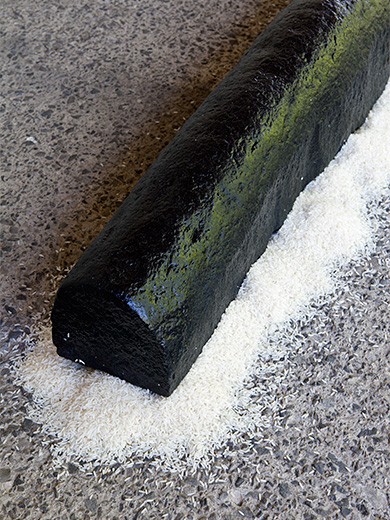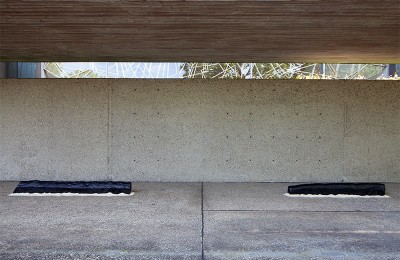Wolfgang Laib
Reishaus, 2007/2008

Blockhaft und massiv wie Gebirgsrücken - lagern am Zürcher Friedhof Eichbühl Reishäuser. Gestrandete Relikte aus einer anderen Welt, aus einer anderen Zeit? Der süddeutsche Künstler Wolfgang Laib (*1950,) hat sie aus dunklem, indischem Granit geschlagen und mit in Sonnenblumenöl verrührtem Russ geschwärzt. Dann schüttete er die monolithischen Gebilde an, bettete sie in schneeweissen Reis: Anorganisches zu Organischem, Nährendem, Hart zu Weich, Schwarz zu Weiss. Und Trauer – wir sind ja auf einem Friedhof – zu Leben.
Natur wird Kunst. Das Land-Art-Prinzip ist hier auf sinnliche Weise umgesetzt. Und der 65-Jährige, als Minimalist ebenso Poet und Philosoph, zieht sich offensichtlich gern vom weltlichen Hasten, Treiben, Trachten zurück, nur auf du und du mit der Natur. Sie ist für ihn, der Medizin studierte, bevor er ganz in die Kunst ging, ein sinnlich erfahrbares Mittel. Keineswegs aber ist sie Ziel seiner Arbeit, vielmehr Arbeits- und auch Andachtsraum. Mithilfe der Natur kann er – der sich mit Zen-Buddhismus und Taoismus ebenso befasst wie mit der Mystik der Antike und des Mittelalters, etwa z.B. Franz von Assisi – auf grössere Zusammenhänge verweisen: auf Ganzheitlichkeit etwa, in der fernöstlichen Zen-Philosophie auch Kokoro genannt. Alles hängt mit allem zusammen, Mensch, Tier, Pflanze, Elemente. Mit dieser Lebenssicht, der Beschäftigung mit dem Elementaren und mit dem Aspekt Zeit, kann Laib keine seiner – zeitlosen – Arbeiten endgültig abschliessen. Sie bestehen gleichwertig nebeneinander. Er baut sie auf und wieder ab, zeigt sie an anderen Orten. Ein notwendiges Ritual der Entstehung als Wiedererstehung. Und immer wieder tauchen diese Chiffren in seinen Skulpturen auf: Wachs, Blütenpollen, Samenkörner, Öl, Milch, in Marmorstein getröpfelt und gerieben. Auch Reiskörner und, als Urform für das Haus: die Behausung.
Ein Haus, sagten die griechischen Stoiker, gebe dem menschlichen Leben eine Mitte, zugleich sei es Symbol des Kosmos, weil auch die Götter darin lebten. Vom «Haus der Weisheit» ist in alten fernöstlichen Schriften die Rede – und vom Ort der Geborgenheit in Überlieferungen des frühen Christentums.
Vor einiger Zeit noch formte Laibähnliche Reishäuser, aber die waren weiss, errichtet aus Marmor ohne jede Äderung. Man könnte also meinen, der Künstler habe seine schwarzen Reishäuser jenen landestypischen dunklen Granithäusern angepasst, wie sie, zwei Fahrtstunden von Zürich entfernt, an den steilen Hängen im Tessin zu finden sind, angeschmiegt an die schroffen Berge. Vor den Fenstern derbe hölzerne Laden, robuste, sturmgeschützte, schnee- und kältesichere Behausungen. Schutzräume vor der majestätischen, aber auch harten Natur, die uns Menschen nicht braucht, während wir umso mehr auf sie angewiesen sind.
Und so taucht man beim Anblick von Wolfgang Laibs Reishäusern ein in eine andere Ordung des Da-Seins zwischen Beständigem und Flüchtigem, zwischen Fülle und Leere, zwischen Realem und Irrationalem. Ein meditatives Erlebnis, das in unserer rasanten, oberflächlichen, medialen Welt rar und kostbar geworden ist. Ingeborg Ruthe
Courtesy the artist und Buchmann Galerie, Berlin/Lugano
Dank an: Torsten Seidel und Martin Schugk
English Version
At Zurich’s Eichbühl Cemetery, there is an encampment of Rice Houses, block-shaped and solid like mountain ridges. Stranded relics from another world, from another time? South German artist Wolfgang Laib (b. 1950, Germany) hewed them from dark Indian granite and blackened them with a mixture of sunflower oil and soot. He then banked up these monolithic forms, embedding them in snow-white rice: the inorganic alongside the organic and nourishing, hard alongside soft, black alongside white. And mourning (we are, of course, in a cemetery) alongside life.
Nature becomes art. Here, the principle of land art is implemented in a manner that appeals to the senses. It is also apparent that this 65-year-old, as a minimalist, poet and philosopher, likes to withdraw from the rushing, driving and striving of this world, to a comfortable relationship with nature. For this former medical student, who later devoted himself entirely to art, nature is a medium that can be experienced in a sensory way. How-ever, nature is by no means the objective of his work and is instead a space for work and meditation. As someone who addresses Zen Buddhism and Taoism just as much as ancient and medieval mysticism (as practised by Francis of Assisi, for instance), nature enables him to make reference to wider contexts, such as that of holism, which is also called kokoro in the Zen philosophy of the Far East. Everything interrelates with everything else: humans, animals, plants and the elements.
With this view of life, engaging with the elementary and the aspect of time, Laib cannot bring any of his (timeless) works to a final end. They exist side by side, equal to each other. He sets them up, dismantles them again and exhibits them at other locations. An essential ritual of emergence as a revival. More-over, these codes appear in his sculptures again and again: wax, pollen, grains, oil and milk, trickled and rubbed into marble. Also grains of rice and, as the archetype of the house: the dwelling.
The Greek stoics said that a house provided a centre for human life and was simultaneously a symbol of the cosmos, because the gods also lived inside them. Ancient writings from the Far East refer to the “house of wisdom” – and written records from early Christendom refer to the place of comfort.
Some time ago, Laib used to sculpt similar rice houses, but they were white, made from marble without any veining. Thus, it could be supposed that this artist has adapted his black rice houses to the dark granite houses typical of this country, as can be found two hours’ drive from Zurich on the steep slopes of Ticino, clinging to the rugged mountains. Robust dwellings with solid wooden shutters in front of the windows, protected against storms, snow and the cold. Refuges that provide shelter from nature, which is majestic but also harsh, and which has no need for us humans, while we are all the more dependent on it.
Thus, the observer of Wolfgang Laib’s Rice Houses immerses themselves in a dif-ferent order of existence, between the enduring and the fleeting, between fullness and emptiness, between the real and the irrational. A meditative experience that has become rare and precious in our fast-paced, superficial, medial world. Ingeborg Ruthe
Courtesy of the artist and Buchmann Galerie, Berlin/Lugano
Thanks to Torsten Seidel and Martin Schugk

